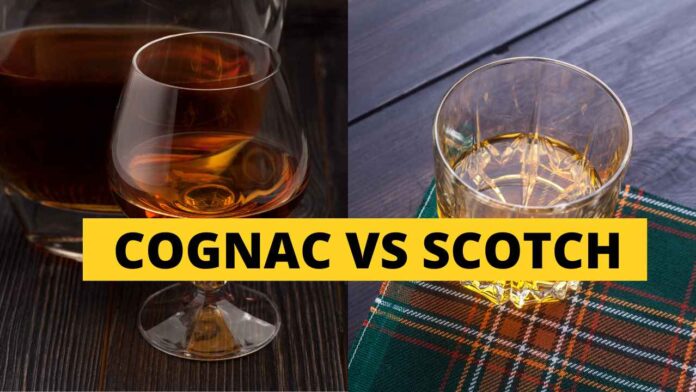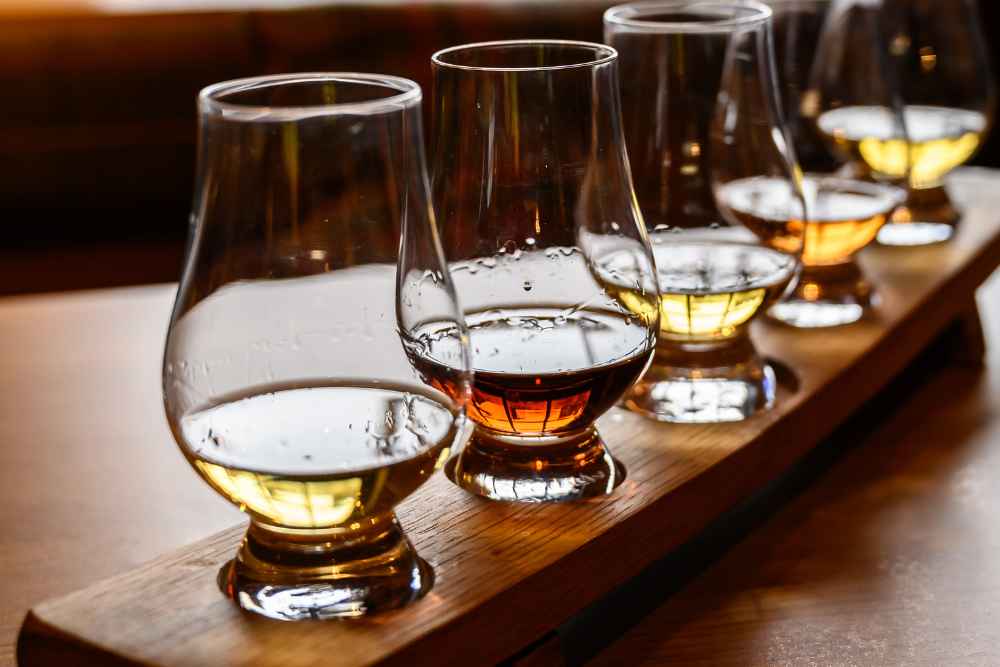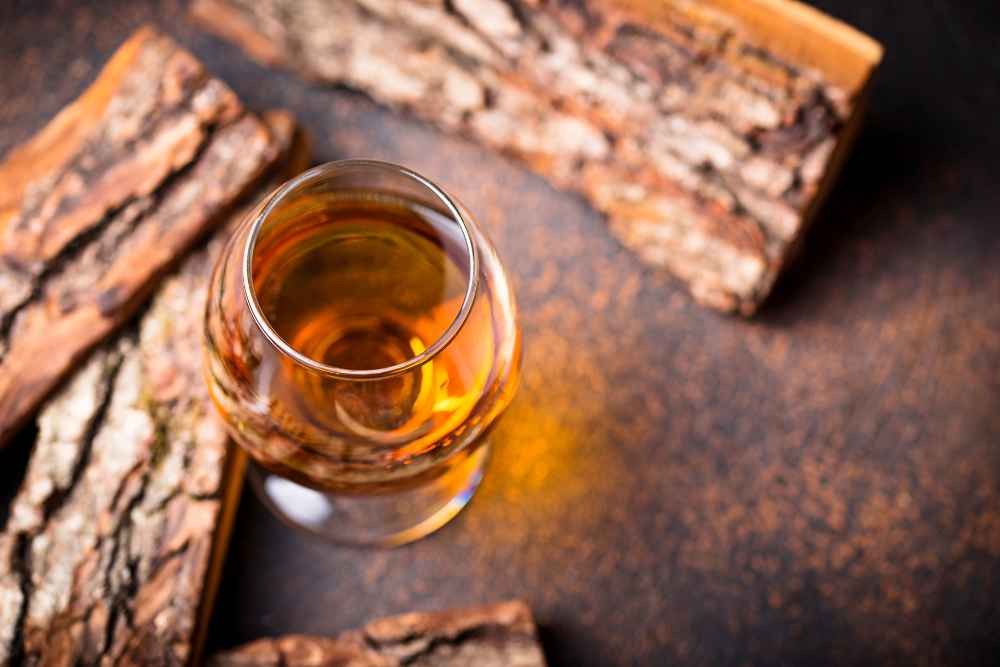This page may contain affiliate links. Please see our Disclaimer for more information. Always drink responsibly and adhere to your local legal drinking age.
Introduction
Spirits lovers, prepare to embark on a captivating journey as we dive deep into the world of Cognac and Scotch. These two iconic beverages have captured the hearts and taste buds of people worldwide, yet they remain shrouded in mystery for many.
In this guide, we’ll unravel their fascinating history, production processes, unique flavors, and presentation styles – everything you need to become a fan! So sit back, pour yourself a glass (or two), and join us as we delve into the alluring realm of Cognac vs. Scotch: A Guide for Spirits Lovers.
Key Takeaways:
- Cognac is made from grapes, while Scotch whisky is made from malted barley and other grains.
- The aging process plays a significant role in creating the unique flavor profiles of both spirits. Cognac requires at least two years in French oak barrels, and Scotch needs at least three years in any type of oak barrel.
- Cognac has VS, VSOP, and XO classifications based on the aging period, while Scotch can be a single malt, blended, or grain variety.
- Understanding regional distinctions between the production areas of these spirits can help guide your selection. For instance, under strict regulation, cognac is exclusively produced in France’s Cognac region. Meanwhile, Scotches are categorized into five regions – Highland, Lowland Speyside Islay, and Campbeltown – each having their signature style based on climate and local resources available for distillation.
Understanding Cognac And Scotch
Cognac and Scotch are two distinct types of spirits, with cognac being made from grapes while Scotch is made from malted barley.
Origins And Production Processes
Cognac and Scotch whiskies have deep-rooted histories in their respective countries, with both beverages being revered for centuries. Cognac hails from the southwestern region of France, where it has been produced since the 17th century.
Despite sharing similar production processes at their core – the art of distillation – these two spirits differ significantly in ingredients and techniques employed throughout the process.
Cognac begins with white wine grapes, primarily Ugni Blanc, grown exclusively within the designated regions of cognac-making: Grande Champagne, Petite Champagne, Borderies, Fins Bois, Bons Bois, and Bois Ordinaires.
The harvested grapes are first fermented into wine before undergoing double distillation in copper pot stills known as alembics charentais, resulting in a clear spirit called “eau-de-vie”.
Scotch whisky’s production starts with grains – principally barley malted- soaking it in water until germination occurs when enzymes convert starches into fermentable sugars.
After kilning or drying out under heat to stop further germination, this malt is ground up and mixed with hot water to extract a sugar-rich liquid referred to as wort. Yeast is added next for fermentation yielding a beer-like wash rich in alcohol that later gets distilled twice using copper pot stills or continuous column stills depending on whether it’s single malt (made from only malted barley) or grain whisky (made from other cereal grains like corn).
The final spirit matures inside charred American ex-bourbon casks or European sherry oak casks, imparting rich flavors and aroma profiles quintessential to each kind of scotch whisky before bottling at no less than 3 years.
Differences In Ingredients And Aging
A primary distinction between Cognac and Scotch lies in their ingredients. Cognac is crafted from white grape varieties, predominantly Ugni Blanc, while Scotch whiskey comes from a fermented grain mash that typically includes malted barley and other grains like corn or rye.
The aging process adds another layer of complexity to these spirits. For Cognac to be called such, it must age for at least two years in French oak barrels; however, many premium examples will mature significantly longer.
Oak imparts flavors like vanilla, caramel, and spice and allows the unique terroir of the eaux de vie to shine through. On the other hand, Scotch whisky’s minimum aging requirement is three years with no specific barrel type mandated; some are aged exclusively in American bourbon barrels, whereas others use sherry casks or even Japanese Mizunara oak for an added depth of flavor.
Flavor Profiles And Serving Options
Cognac and Scotch whiskies boast unique flavor profiles, making them ideal for different serving options. Cognac’s smooth, fruity characteristics stem from its grape-based origins; expect notes of vanilla, caramel, and dried fruits within each sip.
Neat is a popular way to serve the spirit at room temperature so its luxurious flavors can shine through.
On the other hand, Scotch whisky provides an array of flavor experiences depending on where it’s produced – from smoky peatiness in Islay to subtle sweetness in Speyside varieties.
When savored neat or with a drop of water, Scotch releases rich layers of aroma and taste, which avid whiskey fans often appreciate. Many cocktail drinkers find these spirits enjoyable when used as a base for innovative concoctions such as Rob Roy or Blood & Sand; they add depth and complexity while complementing other ingredients impeccably.
Key Differences Between Cognac And Scotch
Cognac and Scotch differ in their aging requirements, with Cognac needing at least two years of aging in oak barrels while Scotch requires a minimum of three years.
Aging Requirements
Cognac and Scotch have specific aging requirements contributing to their distinct flavor profiles. Cognac must be aged in oak casks for at least two years, while some high-end cognacs can be aged for decades.
The legal minimum aging period varies by country for whisky, but single malt Scotch must be aged in oak barrels for at least three years.
For example, older whiskies tend to develop richer flavors from the wood barrels they are stored in. On the other hand, if you prefer a lighter flavor profile, younger spirits may suit your preferences better.
Flavor Profiles And Tasting Notes
Cognac and Scotch have distinctive flavor profiles that make them unique. Cognac has a smooth, fruity taste with hints of vanilla and nutmeg, while Scotch is smoky with varying sweetness depending on the type.
For instance, Grande Champagne cognacs tend to be floral with accents of citrus and honey, whereas Borderies offer more aromatics like violet petals combined with orange blossom.
In comparison, single malt scotch whiskies from Islay showcase peat smoke and iodine as their signature note. At the same time, Lowland whiskies are lighter-bodied drinks marked by a heather-honey character that is refreshing on the tongue.
Regional Distinctions
One major difference between cognac and Scotch is their regional distinctions. Cognac is exclusively produced in the Cognac region of France, where strict regulations govern its production.
The region is divided into six appellations: Grande Champagne, Petite Champagne, Borderies, Fins Bois, Bons Bois, and Bois Ordinaires.
On the other hand, Scotch whisky can only be called “Scotch” if it’s made in Scotland using specific ingredients and methods. There are five recognized regions of Scotch production: Highland, Lowland, Speyside Islay, and Campbeltown.
Understanding these regional differences can help cocktail drinkers make informed choices when selecting spirits to use in their drinks or simply enjoying them straight up or on ice.
Types Of Cognac And Scotch
Types of Cognac include VS (Very Special), VSOP (Very Superior Old Pale), and XO (Extra Old), while Scotch can be a single malt, blended, or grain variety.
VS, VSOP, XO Classifications For Cognac
Cognac is divided into three classifications: VS, VSOP, and XO. The letters stand for “Very Special,” “Very Special Old Pale,” and “Extra Old,” respectively. But what do these designations mean? In general, the age of Cognac determines the classification it receives.
A standard VS Cognac has been aged in oak barrels for at least two years, while a VSOP must be aged for four years or more. Meanwhile, an XO Cognac has to be aged in oak casks for no less than six years.
Single Malt, Blended, And Grain Varieties For Scotch
Scotch whisky has three main categories: single malt, blended, and grain. Single malt is made from only water and malted barley at a single distillery using copper pot stills.
The flavor can vary depending on the region it’s produced in with Islay whiskies being smokier while those from Speyside tend to be lighter and sweeter. Blended scotch is a mix of different whiskies from various distilleries, giving the master blender greater control over the final taste profile.
It’s by far the most consumed type of scotch, making up over 90% of sales worldwide due to its balance between cost and quality. Grain whiskey is made from various grains that have been distilled continuously in column stills, resulting in a much milder flavor than other types of scotch.
Popular Brands And Regions Of Production For Both
Regarding popular brands of Cognac, Hennessy and Martell are household names that have been enjoyed for generations. These historic houses produce a wide range of cognacs, from entry-level VS to premium XO blends.
In terms of production regions, most Cognac is produced in the southwestern region of France, known as the Charente-Maritime.
Meanwhile, Scotch whisky has many notable brands, such as Johnnie Walker and Macallan, which offer an extensive range catering to all palates – from smoky Islay single malts like Lagavulin to fruity Speysides like Glenlivet or Aberlour.
Scotland is divided into various whisky-producing regions with distinct characteristics that influence flavor profiles; these include Lowlands (lighter malt), Highlands (more complex malt), Speyside (fruity malt), Islands (smoky/distinctive), Islay (heavily peated/smoky).
Price Comparison Between Cognac And Scotch
Compare prices of different classifications for cognac and scotch based on factors such as aging, production methods, and region of origin.
Factors That Affect Prices
One of the main factors affecting Cognac and Scotch’s prices is their age. The longer a spirit has aged, the more expensive it becomes because of its unique flavor.
Another factor that contributes to pricing is the rarity of certain brands or editions. Limited releases, special collaborations, or vintage collections can skyrocket in price due to their exclusivity.
Lastly, marketing strategies such as packaging design, advertising campaigns, or sponsorships can also impact pricing. Like any luxury brand or product category, spirits companies invest heavily in branding and promotion to attract consumers and establish themselves as premium choices in the market.
In conclusion..
Spirits lovers will find that understanding what affects pricing differences between Cognac and Scotch can help them make informed purchases based on personal preferences and budget constraints.
Average Prices For Various Classifications
The average prices of Cognac and Scotch can vary significantly depending on their classification, age, and brand. Here’s a breakdown of the average prices for various classifications of Cognac and Scotch for cocktail drinkers.
| Classification | Cognac | Scotch |
|---|---|---|
| VS (Very Special) | $30 – $50 | N/A |
| VSOP (Very Superior Old Pale) | $50 – $100 | N/A |
| XO (Extra Old) | $100 – $300+ | N/A |
| Single Malt | N/A | $40 – $100+ |
| Blended | N/A | $20 – $100+ |
| Grain | N/A | $30 – $80+ |
These price ranges should be considered a general guideline, as individual factors such as brand, region, and limited editions can influence the cost. Additionally, some Scotch whiskies may be aged in French oak barrels, as mentioned in the important facts, which can impact their taste and price. As you explore the world of Cognac and Scotch, consider sampling a variety of classifications and price points to determine your favorite spirits for cocktails.
Tasting Cognac And Scotch
Experience the full flavor and complexity of cognac and scotch by following these basic tasting guidelines. From detecting common notes and aromas to exploring different serving temperatures and glassware, you’ll learn everything you need to know about enjoying these two celebrated spirits.
General Tasting Guidelines
When it comes to tasting Cognac and Scotch, a few guidelines can enhance the experience. First, start with the spirit’s appearance – note its color and viscosity.
Swirl the glass gently to release aromas, then take a sniff. Identify any notes you can detect, such as honey or smoke. Finally, take a sip and let it roll over your tongue before swallowing or spitting out.
It’s worth noting that personal taste plays an important role in enjoying spirits like Cognac and Scotch. Some people may prefer their drink neat, while others will want water or ice added to temper its intensity.
Also, different serving temperatures may alter how intense certain flavors come across. For example, warmer temperatures bring out more complexity in most whiskies but can lessen some subtler notes in Cognac.
Descriptions Of Common Notes And Aromas
The aromas and notes in cognac and scotch can vary widely depending on the specific spirit, aging process, and other factors. When tasting cognac, you may pick up apricot, caramel, prune, orange, or vanilla aromas.
On the other hand, scotch often has smoky or peaty notes along with hints of spice or caramel.
When savoring either of these spirits neat or mixed into a cocktail creation, it’s important to take note of the various notes and aromas that come through.
Advantages And Disadvantages Of Various Serving Temperatures
Serving temperature can greatly affect the drinking experience of both Cognac and Scotch. For instance, serving these spirits at room temperature can bring out their full flavor but may also make them overly harsh.
One advantage of slightly chilled Cognac is that it can help mellow its strong alcohol content, making it smoother on the palate. However, Cognac’s aroma and subtle flavors may be muted when served too cold.
Meanwhile, Scotch is often best enjoyed at room temperature or slightly below to allow its complex aromas and flavors to fully develop in your glass.
Overall though, personal preference plays a huge role in determining the ideal serving temperatures for each spirit- Some people prefer their spirits neat or warmed up. In contrast, others love cocktails made using whiskey as an ingredient or enjoy it mixed into highballs over ice.
Recommended Glassware
Choosing the right glassware is crucial for enhancing cognac and scotch drinking experience. The recommended type of glassware for these spirits is aroma glass, which features a tulip shape that allows you to swirl and aerate your drink, bringing out its unique flavors and aromas.
For those who prefer a more traditional approach, snifter glasses are also popular choices. These glasses have a short stem, allowing you to hold them comfortably while warming up the spirit slightly with the warmth from your palm.
Alternatively, rocks glasses can be used for serving whiskey cocktails or on-the-rock drinks as their heavier base reduces spillage risks.
Pairing Cognac And Scotch With Food
Pairing cognac and scotch with food can enhance the dining experience, with cognac being a great match for rich dishes like foie gras or chocolate desserts, while scotch pairs well with seafood and smoked meats.
Basic Pairing Guidelines For Spirits
Pairing spirits with food can be a tricky affair, but when done right, it can elevate both your meal and drinking experience. When pairing Cognac or Scotch with food, there are some basic guidelines.
Generally, heavier dishes like red meat and cheeses pair well with the full-bodied flavor of Cognac, while lighter fare like seafood and vegetables go better with the subtler notes of Scotch.
For example, Cognac pairs beautifully with chocolate desserts – try serving rich chocolate truffles alongside a glass of VSOP cognac for a decadent treat.
Most importantly, remember that personal taste should always prioritize over strict rules when pairing whiskey or brandy with food.
Specific Food Pairing Suggestions For Cognac And Scotch
Here are some suggestions for pairing Cognac and Scotch with food:
- Fish: Floral Cognacs pair well with fish dishes, such as oysters, salmon, or shrimp. The lightness of the seafood contrasts well with the complex flavors of the cognac.
- Chocolate desserts: Cognac’s sweetness and nutty undertones make it an excellent complement to chocolate desserts. Try serving a VSOP or XO Cognac alongside a rich chocolate cake or truffles.
- Cheese and nuts: Scotch pairs well with cheese and nuts. Try aged cheddar with a spicy rye whisky or blue cheese with a smoky single malt Scotch.
- Shellfish: A gentle whisky is ideal for pairing shellfish, such as lobster or crab. Choose a lightly peated whisky that won’t overpower the delicate seafood flavors.
- Red meat: A strong whiskey works best for red meat and greasy food sources like burgers and BBQ ribs. Bourbon is particularly good in this pairing.
- Culinary experiments: Don’t be afraid to experiment with new culinary pairings – Cognac’s rare spirit is built for fun culinary explorations!
Enjoying Cognac And Scotch
Learn the art of drinking spirits and discover decorative and practical ways to present and store your bottles for an enhanced experience.
The Art Of Drinking Spirits
Drinking spirits is more than just a simple act of sipping your drink. It’s an experience that should be savored and appreciated to its fullest potential. One important aspect of this art is choosing the right glassware, as it can affect your drink’s taste, aroma, and appearance.
For example, tall glasses are great for cocktails with lots of ice, while rounded glasses enhance the flavor notes in whiskey or cognac. Temperature is also essential; room temperature brings out the flavors in aged liquors, while chilled temperatures enhance fresh fruity drinks.
So if you want to elevate your drinking experience beyond just a mere nightcap but instead towards a refined and indulgent ritual, then certainly consider these factors when pouring yourself a dram or cocktail at home or when enjoying it with friends at social events!
Decorative And Practical Ways To Present And Store Bottles
As a spirits lover, you know that the presentation of your favorite bottle is just as important as the taste.
One option is investing in an elegant decanter for cognac or scotch. These come in various shapes and sizes and can add a touch of sophistication to any bar setup.
Another practical solution is to use specialized trays or stands designed to hold multiple bottles securely while still being easily accessible for pouring.
For those with limited space, vertical wall-mounted racks or shelving units can be convenient and visually appealing.
Cocktails, Collections, And Limited Editions
Cocktail enthusiasts can experiment with classic and modern recipes using both cognac and Scotch. At the same time, collectors may seek out rare or limited edition bottles from popular brands such as Hennessy, Macallan, or Lagavulin.
Classic And Modern Cocktails For Both Drinks
Cocktails are a great way to enjoy Cognac and Scotch, and there are many classic and modern recipes. Here are some popular options for both spirits:
- Classic Cognac Cocktails:
- Sidecar
- French 75
- Sazerac
- Vieux Carré
- Brandy Alexander
- Modern Cognac Cocktails:
- The Matador (Cognac, pineapple juice, lime juice)
- The French Smash (Cognac, mint leaves, lemon juice, simple syrup)
- The Dusky Conquistador (Cognac, Cardamaro Amaro, apricot liqueur)
- Classic Scotch Cocktails:
- Old Fashioned
- Rob Roy
- Blood and Sand
- Rusty Nail
- Scotch Sour
- Modern Scotch Cocktails:
- The Penicillin (Scotch, honey-ginger syrup, lemon juice)
- The Smoky Scotsman (Scotch, Lapsang Souchong tea syrup, orange bitters)
- Highland Fling (Scotch, Amontillado Sherry, simple syrup)
Whether you prefer classic or modern cocktails, there’s a recipe for every taste. And if you’re looking for a gift for the cocktail lover, consider picking up a book of cocktail recipes or investing in some quality barware to help them create their own signature drinks at home.
Rare And Sought-after Bottles
Collecting rare and sought-after bottles can be an exciting hobby for cocktail enthusiasts. Some of the most expensive liquor bottles on the market are highly coveted among connoisseurs, including vintage cognacs and scotches.
Limited edition collaborations between top distilleries and world-renowned chefs or artists also make for unique additions to a collection. For example, in 2015, The Macallan released a limited edition line in collaboration with fashion designer Fabien Baron that featured luxurious packaging he designed.
Collectors should research auction houses like Sotheby’s or Christie’s for opportunities to bid on rare bottles and watch for specialized retailers that carry exclusive releases or aged spirits from long-gone distilleries.
Special Releases And Collaborations
Special releases and collaborations have become increasingly popular in Cognac and Scotch, with brands teaming up with artists, designers, and other distilleries to create limited-edition bottles.
For example, Remy Martin Louis XIII collaborated with Hermès on a special decanter for their cognac. Similarly, Johnny Walker has released a Game of Thrones-themed scotch collection.
In addition to these collaborations, rare and sought-after bottles of Cognac and Scotch are available on the market. Some examples include Hennessy Paradis Imperial or Macallan 1946, which can cost thousands of dollars per bottle.
FAQ
Q: What is the difference between cognac and whiskey?
A: Cognac is a type of brandy made from white grape, while whiskey is a spirit made from a base product like grains or malted barley.
Q: Can cognac be made from any grape?
A: No. For a grape to make cognac, it must be grown in the Cognac region of France and adhere to strict production regulations.
Q: Is bourbon whiskey a type of cognac?
A: No, bourbon is an American whiskey made from corn mash. Cognac is a specific type of brandy produced in the Cognac region of France.
Q: How is cognac made?
A: Cognac is made by distilling white grape wine from the Cognac region of France, then aging it in oak barrels for a minimum of two years. The distillation process is done in copper alembic stills.
Q: Can whiskey be made from grapes?
A: While whiskey can be made from various base products, it is not typically made from grapes like cognac. Whiskey is usually made from grains or malted barley.
Q: What are some popular cognac brands?
A: Some popular cognac brands include Hennessy, Remy Martin, Courvoisier, and Martell.
Q: What are some popular whiskey brands?
A: Some popular whiskey brands include Jack Daniel’s, Jim Beam, Maker’s Mark, and Jameson.
Q: How does the taste of cognac differ from whiskey?
A: Cognac tends to have a smoother, more complex flavor profile with fruit and spice notes. On the other hand, whiskey can have a wide range of flavors depending on the type and production method.
Q: Can whiskey be used in cocktail recipes that call for cognac?
A: Yes, whiskey can often be used as a substitute for cognac in cocktail recipes. However, it may change the flavor profile of the drink.
Q: What makes a cognac a “VS” or “VSOP” quality?
A: The terms “VS” (Very Special) and “VSOP” (Very Special Old Pale) indicate the age of the cognac. VS cognac must be aged for a minimum of 2 years, while VSOP must be aged for a minimum of 4 years.
Conclusion: Cognac Vs. Scotch, Which One Is Right For You?
In conclusion, whether you prefer the grape-based sophistication of cognac or the malted richness of Scotch, it all comes down to personal taste. Both spirits have distinct differences in their production processes and flavor profiles that make them unique.
Whether you’re a cocktail lover or a solo sipper, understanding the key differences between these two distilled spirits can enhance your drinking experience.
So indulge in a glass (or two) of Cognac or Scotch tonight – cheers!





















